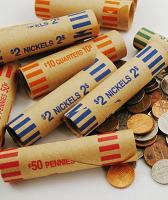Welcome to Part II of
the no-fail budget lesson. We recommend you start with Part I if you haven’t
already read it.
Did you do your homework? Did you list out all your
expenses, even your debt payments and your new ‘allowance’ amount? Good. Let’s
get this ball really rolling.
THE CHART:
Now, you’re going to put all your expenses into this chart:
 |
| If it's too small or you want a pdf, email us. |
I’ve filled out a fake one here just to show you the basics:
To be clear: the top part is for monthly expenses; then the
two pay periods of the month are below. I often write the week’s dates in the
margin, ie “Dec 7-14”. And this may sound nuts, but I print this off the
computer each month. That way it’s in my planner, and it’s way more tangible…like
a contract with yourself.
The first pay period of the month is usually the one with
the most expenses, but using this chart, you may be able to balance it out by
moving some things around. For instance, money for toiletries could be moved to
pay period 2.
MAY I HAVE THE ENVELOPE, PLEASE:
So now you’ve got all these numbers in a very simple table.
And if this is where your strategy ends, you will likely find yourself back
here in a couple months with a big FAIL written across your spreadsheet. Why?
Because money has become intangible, and that makes it easier to spend. Debit
cards and credit cards feel endless. We can always squeeze five more bucks out
of them. And then suddenly, we realize we’re $300 overdrawn. So what can we do?
We get envelopes.
I keep a steady flow of those slim-fitting banker’s
envelopes around the house. And in my wallet, I divide out each of my cash
allotments with a note at the top of the envelope. I bought a long ‘pocket book’
style wallet to hold these envelopes; if you don’t want to do that, you can
admittedly leave the majority of the envelopes at home most days. And I still
put my regular allowance into my cute tri-fold wallet, because that’s
discretionary spending so I don’t need to keep it as ‘segregated’.
When I go to the grocery store, I pull out my grocery
envelope and hand over the cash. Likewise for the pharmacy. Other ‘extra
expenses’, like a haircut, have a temporary envelope…I bring that, too. Each
payday, I go to the bank, take out in cash anything that isn’t sent
electronically to a bill collector or landlord (etc), and make these envelopes.
You may feel silly doing this. That’s pride effing with you.
You know when I feel really proud? When I follow this system and, for example,
manage to amass enough cash to go on a vacation.
Because what happens with this system is that you don’t
overspend; and sometimes, when you’re lucky, you underspend. What do you do with the extra cash? You can keep it for
an extra-large grocery shop, or you can put it in your ‘sock money’ place (your
savings, that you may or may not keep in a sock).
Note: if envelopes are just not going to work for you, try
paper clips with post-it notes: fold the money in half, paper clip the bundle,
and get a tiny post-it for the front where you write what that money is for. Only
trouble is that you can’t paperclip coins.
WHAT ABOUT DEVELOPING CREDIT?
I have a credit score, and primarily that’s developed
through purchasing larger items. When I bought a new computer last year, I paid
with my Visa, after checking my spreadsheet and seeing what money I had.
Sometimes I pay for something with Visa because it’s online (ie paying for
movie tickets in advance), but I have a VISA envelope in my wallet, and I
diligently take my movie money out of my ‘allowance’, and move it over to that
envelope. Next payday, I put all the accumulated VISA envelope money into the
bank.
WHEN YOU’RE A COUPLE:
Brian and I have divided some expenses (ie. He pays for half
the groceries); for expenses we’ve split down the middle like this, we each
withdraw it from our accounts, and then put it in one shared envelope. For
example, since I’m the grocery shopper usually, I keep that envelope and Brian
gives me his cash to add into it.
For other expenses, we may not split equally; Brian might
deal with the cable bill, while I deal with the car insurance--an e-payment. As long as you
talk it out, it’ll be fine. Sometimes the reality is that one person makes less
money than the other; that’s okay! Just figure out how each of you can sensibly
contribute.
FAILURE IS A PART OF LIFE.
You may try this system and screw up along the way. Some
people adopt it and find that it’s super easy to keep doing. Some of us have
learned the joys of instant gratification…and it will take us longer to put
away the Debit card. What do you do when you screw up? Print another sheet and
start again.
Give this system a try; I dare you! Let me know if you are
confused on any of it, or if you need help. And tell me how you do.
I would LOVE to hear from you.
-----------------------------------------------------------------------------------------------------------
BONUS TIPS:
SEASONAL EXPENSES: Property tax, dental cleanings, and flu
medicine are the type of unexpected expense that can screw you up. Ideally you’ll
have a pool of ‘sock money’ (savings) that you can dip into if you need it. But
if you don’t and you have to use your credit card, just be sure to increase
your payment ‘til you get it paid back down. Of course, there’s always the good
ol’ garage sale: sell some stuff, or work for a weekend. Brian often helps out
with a friend’s business to get a little extra spending money.
BONUS MONEY: When you get an income tax return or birthday
money, think before you spend. This money should ideally never be worked into
your budget, so it can remain fun and carefree, but I still keep a wishlist of
purchases in my planner so that, when the birthday money shows up, I know
exactly where I want to spend it. This self control has helped me to have some
pretty great luxuries. (PS.: if your electrical bill is overdue, you may have to
bite the bullet and give this bonus money over to the electrical company.
Sorry.)
BONUS TIP FOR MONEY DUMMIES: I’m a money dummy. I need to see money in front of me to understand
what I’m doing. So consequently, I have a stack of Monopoly money that I bought
just for this reason. If I have a large bundle of expenses coming up, I pull
out the monopoly money to figure it out. For instance, back in college I
managed (with this system) to save up enough money for a cruise. I knew I had
to pay x-amount to my Visa for the booking, x-amount to Mom for the flight
booking, and x-amount for on-ship expenses. Soon I realized there were tons of
different pockets of money I needed to be sure to pay. I counted out exactly
how much (Monopoly) money I had for this trip, then laid out post-its with the
titles (ie. VISA, FLIGHT, EXCURSION FEE) and put my Monopoly money in front of
each one. This allowed me to realize that after all the travel expenses were
paid off, I still had $300 for shopping. Woo hoo!

 Our good friend Jen Winter,
owner and chocolatier at Koko Chocolates, asked us to review two of her new
spring/summer flavours. With Mother’s Day right around the corner, we figured
many of you might be looking for something traditional to gift—but with a
little twist. Why pick up the usual box of big-brand chocolates for Mama when
we have scrumptious truffles handmade by a local artisan just around the
corner? And make no mistake, Koko chocolates are probably closer to you than
you realize: they are now being carried at various retailers including The
Candy Store in Westboro, and other
great shops (or online).
Our good friend Jen Winter,
owner and chocolatier at Koko Chocolates, asked us to review two of her new
spring/summer flavours. With Mother’s Day right around the corner, we figured
many of you might be looking for something traditional to gift—but with a
little twist. Why pick up the usual box of big-brand chocolates for Mama when
we have scrumptious truffles handmade by a local artisan just around the
corner? And make no mistake, Koko chocolates are probably closer to you than
you realize: they are now being carried at various retailers including The
Candy Store in Westboro, and other
great shops (or online).  This truffle is a real treat,
and way too easy to eat. The chocolate shell of this truffle manages to be rich
but not overpowering, as your teeth sink down into the white chocolate centre.
This creamy ganache has a distinctive “cheesecakey-ness”, with a rich denseness
to it. The taste of lavender is subtle in this chocolate, which Brian liked, but
I—a seasoned lavender-chocolate muncher—would have been happy to have
amplified. It was delicious, however, and a pleasant introduction to the almost
rosemary-like taste of lavender that would be a new experience for many
chocolate eaters. Brian felt that with its floral, bright, yet calming flavour
notes, this chocolate should be eaten on its own. I added, yes: in large
quantities.
This truffle is a real treat,
and way too easy to eat. The chocolate shell of this truffle manages to be rich
but not overpowering, as your teeth sink down into the white chocolate centre.
This creamy ganache has a distinctive “cheesecakey-ness”, with a rich denseness
to it. The taste of lavender is subtle in this chocolate, which Brian liked, but
I—a seasoned lavender-chocolate muncher—would have been happy to have
amplified. It was delicious, however, and a pleasant introduction to the almost
rosemary-like taste of lavender that would be a new experience for many
chocolate eaters. Brian felt that with its floral, bright, yet calming flavour
notes, this chocolate should be eaten on its own. I added, yes: in large
quantities. 

































